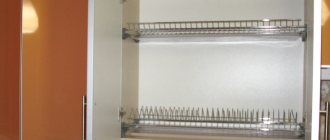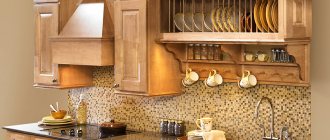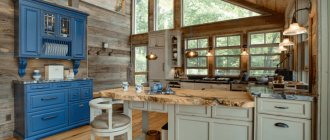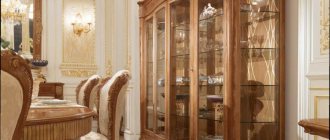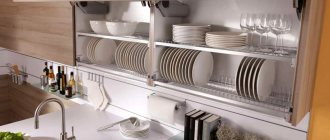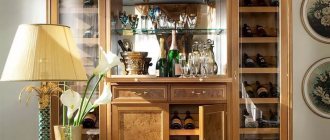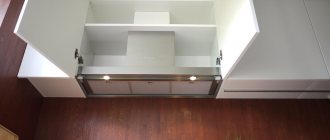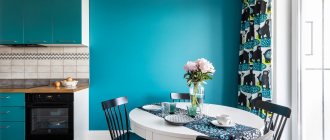Design features of different dryers. Shelf material
The material of the dryer plays a significant role. The most budget option is plastic. It has a nice design and lightness. But the service life of such a dryer is very short: after a few months it will begin to sag or break completely.
A convenient option is a built-in dish dryer in wall cabinets.
The best, but also the most expensive models are made of metal. Most often these are aluminum and stainless steel. The metal drying rack fits easily into the design of any kitchen and is also durable
But operation must be very careful: a strong impact can damage the dishes
The best dryers are made of metal.
Decorative shelves for the kitchen
When choosing shelves for drying and storing dishes, be guided by the overall style of the kitchen. For example, metal, plastic or even glass shelves are suitable for modern and high-tech. A more relaxed Provence and Scandinavian style involves the use of wood and stone.
When choosing a dish dryer for your kitchen, focus on the overall design.
Decorative shelves can be made of wood and glass
Pay attention to the thickness of the glass, it must support the weight of the dishes.
Open models
Open shelves are not only an excellent decoration, but also a rather functional element of the interior. The absence of a door allows you to immediately take in the entire set of dishes and makes searching much easier. But there is also a drawback: grease and dirt can stain dishes and you will have to spend extra time cleaning the shelves.
Open models perfectly complement the interior.
There are several types of open shelves.
- Mounted. Attached to the wall using hinges. Fasteners can be hidden, but can also be a decorative element.
- Rooms fixed to the ceiling. Hanging shelves look very unusual and at the same time withstand heavy loads. For installation, you will have to make holes in the ceiling, so owners of a stretch ceiling may have problems.
- Shelves and racks. They are placed in spacious rooms due to their large dimensions. Can be mounted to a wall or floor. They are stable and durable.
- Built-in shelves are another option for organizing storage in the kitchen. A shelf for dishes in a kitchen cabinet is built in immediately during installation and is included in the kitchen set, making it more diverse.
Open models of shelves for the kitchen have several types.
This way, unpresentable utensils can be hidden in closed cabinets, and beautiful dishes and decorations can be displayed on the shelves.
Open shelf models can be installed anywhere in the kitchen.
For compact spaces, the option of additional corner shelves built into the closet is also suitable. High shelves made up of several tiers look original. They are quite roomy and a great space saver.
It is convenient to use open shelves above the sink.
Wall cabinets
A dish drying rack in a closet is often just a request. Many housewives appreciated the built-in models. They are very roomy, conveniently located, it is possible to arrange 2-3 tiers. A pallet is highly desirable. Especially for the second tier. It is not entirely hygienic when water dripping from plates ends up on cups and vice versa.
The built-in dish dryer requires ventilation, because... otherwise, a favorable environment will be formed for the development of various fungi and pathogenic microflora. Lattice fronts, mesh bottom and ventilation holes on the sides of the cabinet successfully solve this problem.
Characteristics of corner dryers
Built-in models of corner dryers are one of the most common models. They are most often chosen by housewives, as they are the optimal solution for any modern kitchen. They are easily and firmly mounted in the kitchen set. Such models allow you to hide dishes from the eyes of guests and generally not spoil the picture of a clean and tidy kitchen.
There may also be special stands designed for drying plates, glasses, cups, cutlery and more.
Corner dryers in cabinets, cabinets or drawers can be made of different materials. The only peculiarity is to provide such a design with a deep enough tray so that the flowing water does not go beyond the permissible limits.
Such structures can be free-standing, wall-mounted or built into kitchen furniture.
Tabletop dryers
They are installed on any surface: near the sink or on the countertop. Such dryers can be:
- stationary or folding;
- in one or more tiers;
- with compartments for cutlery.
In order not to spoil the interior, manufacturers offer different models of dryers. They vary in color, design and shape. Therefore, they can complement the overall design of the kitchen.
Dish dryer: principles of separation by type
There are so many of these accessories presented in specialized stores that it makes your eyes wide open. You can choose cheaper or more expensive models. Complex or extremely simple design. How to decide among this diversity?
First, let's look at the types of this device, and they are divided according to several criteria.
By design
This is one of the main criteria for choosing a dryer. What options are possible?
Wardrobe dryers. There are usually a pair of racks for placing cups and plates, as well as a tray made of aluminum or plastic.
Such kits are inexpensive, versatile and can be easily adjusted to the size of your shelf.
Tabletop dryers are another simple option for an open-air installation. Such devices are usually placed directly on the countertop next to the sink.
Typically, they are more “dressy” than those intended for a closed closet. Can be additionally equipped with side shelves for spoons and forks, as well as hooks for cutting boards
Wall-mounted dryers. Such structures are mounted on rails either directly above the sink or next to it. You can hang this drying rack under a cabinet or, if desired, secure it inside the cabinet.
Such items can be removed during general cleaning.
Corner dryers. They are convenient for their economical approach to using free space, but usually hold few dishes.
Such dryers can also be hung in the work area or hidden in a closet
Retractable structures. A very convenient solution for modern furniture. Suitable for use in base cabinets. Such dryers are preferred by older people who find it inconvenient to reach into the upper cabinet.
Comfortable, soft-running slides make it easy to open, remove and place dishes
Built-in dryers. These models are equipped with a fastening system and are made to order to fit the size of the furniture.
Typically, in such designs, each tier has its own tray, which prevents water from flowing onto the dishes of the lower tiers
By material
In addition to design, material is a significant factor in choosing a dryer. What can you find on sale today?
Steel products. These models are painted or galvanized. The paint usually peels off after a year of heavy use, and the rods become rusty from constant contact with water. Galvanized models are more resistant, but after two to three years they turn yellow.
The most durable are chrome grilles, which, if treated with care, will look attractive for ten years
Stainless steel dryers. These structures are considered the most durable, so they are not afraid of water and do not require touch-up or cleaning.
They're not cheap, but it's a fair price for no hassle.
Plastic models. Cheap and bright plastic products look attractive on a tabletop. They are not afraid of water and do not absorb it, they are easy to wash.
Due to their fragility, the models are not very durable and, after a couple of years, lose their original color
Wooden dryers. This is the most impractical option, which makes sense to purchase only if your interior requires it.
Wood absorbs water, can become moldy, darken and become deformed.
By functional purpose
Based on this feature, dryers are divided into only two types:
- For plates - has a trapezoidal shape or a triangle rack for convenient installation of dishes.
- For cups - usually a straight shelf with sides, on which mugs are placed upside down.
Rarely does anyone prefer to use only one form. Typically dryers have both types of shelves
By the number of tiers and method of fastening
Depending on the number of shelves for dishes, dryers can be single-tiered or two-tiered.
Single-tier models can only accommodate plates or cups; they are usually made retractable
Two or more tiers are suitable for installation in cabinets and for desktop placement. Such dryers are more popular.
The mounting method can be removable or fixed. Fixed structures are firmly attached to the walls of cabinets and shelves; they securely hold the dishes. But such models are difficult to wash. You will have to remove the entire shelf and unscrew the fasteners. Removable dryers are more convenient in this regard.
Materials
Modern dryers are made from various types of materials, among which metal is the most widespread. Structures made of ordinary steel are coated with several layers of anti-corrosion substance, thanks to which the metal is protected from negative factors.
The next most popular material used to create dryers is stainless steel. This type of metal is used to create many household items.
Of course, the price of items made of stainless steel is quite high. This is due to the quality of the finished product, its durability and the strength of the kitchen drying system. Even after several years of use, such structures do not lose their appearance; they do not have to be tinted or treated with an additional layer of anti-corrosion substance.
Another popular material for creating a dish drying device is plastic.
In terms of cost, such models have a significantly low level, due to which they attract the attention of most housewives
Of course, it is better to purchase products made from high-quality plastic. Their price is a little higher, but they meet all quality standards. The main thing is that they are harmless; even with prolonged use, the plastic device will not lose its basic properties.
Quite often, housewives choose dryers made of wood for their kitchens. Previously, only wealthy families could purchase wooden accessories, but today almost everyone can afford them. Wooden structures are an ideal addition to the kitchen interior, as they suit any room design.
Accordingly, after several years the dryer will not lose its appearance and basic properties. Manufacturers advise that you independently coat the surface of the wooden dryer with a water-repellent composition approximately once every three years.
Types of dish dryers in the cupboard
To install drying in a cabinet, built-in models are used; there are many varieties of them, each of them differs according to the following criteria.
- Design.
- There are drying racks with many compartments for each type of cutlery;
- Separate options, consisting of several separate elements adapted to the required type of cookware;
The dishes are covered with fronts and do not attract unnecessary, unwanted attention.
- Single-tier and multi-tier;
- For one or more types of cookware.
Regardless of whether you wipe the dishes or put them in the dryer immediately after washing, they will be clean in any case.
- Case material.
Metal - such models are made of steel, then covered with enamel or other protective coating;
The dryers are covered with an anti-corrosion coating.
Stainless steel models are more expensive, but given the constant contact with water, they are a very durable and wear-resistant option;
You will not need to additionally paint the product, since no traces of corrosion appear on it.
Plastic ones are perhaps the most affordable, but also the most short-lived and subject to rapid wear;
The cheapest dish dryers are made from this material.
Wooden ones are environmentally friendly, cost-effective, and aesthetically attractive.
It has been proven that wooden drying racks are best suited simply for storing dishes dry.
- According to the transformation mechanism.
Removable and retractable.
Today, almost any dryer can be bought in a store or ordered online.
All dryers are designed not only to provide high-quality drying, but also to provide comfortable and quick access to dishes. Many people use drying racks as a permanent place to store dishes, so it should be spacious, take into account the dishes used in the family’s everyday life and make it possible to easily get the necessary cutlery.
Preference should be given to models that are made from natural and safe materials.
Why do you need a dish dryer?
After washing the dishes, you need to dry them thoroughly. To do this, you can lay it out on a table or tray, a corrugated surface near the sink. Some housewives prefer to immediately wipe off tableware, porcelain, glass and metal, and place them on cabinets and shelves.
Open dryers are easy to use and unpretentious, in addition, they have a fairly low price.
Of course, all options have the right to exist. But the best way to store utensils is to dry the dishes in a closet. When the surfaces dry naturally, no fabric lint remains on them, and no effort is required to remove water. Many people use drying modules as a storage system and do not put porcelain and glass on shelves. The plate mounted on the edge is easy to remove. Finding the right item in a stack is much more difficult.
For reference. People invented drying racks for dishes at the dawn of civilization. With the development of the technical industry, designs are constantly being improved. Modern models are made from lightweight, durable materials that are harmless to the body.
A little about sizes
If we talk about standard overhead dryers, then the dimensions are mainly dictated by the size of the furniture. Usually only the depth is considered fixed. And this is 200-300 mm. They differ in width, but are subject to certain standards. Again, it all depends on the width of the cabinet. As a result, the width of the dryer can be 50 cm, 60 cm, 70 or 80 cm. Models with a width of 900 mm are rare.
In the case of those built into the lower cabinet, the situation is different. The width, as in dryers for upper cabinets, depends on the size of the cabinet itself. But the size range is shifting towards reduction. You can find dryers with a width of 400, 500 with fastening to the facade, 600 mm. It is extremely rare to come across 300 mm products.
Let's not forget about non-standard solutions. These are mainly dryers installed in corner cabinets or hung on doors. They have their own size range, which is due to the design features of the furniture. Here the pitch is 50 mm. This allows you to find models 75 cm wide with a standard depth, for example. For some, 450 mm may not be enough for installation in the lower base. Here, start from the volume of dishes that you plan to place there. Otherwise, it may turn out that there are a lot of dishes, but not enough space on the drying rack. Hence the problems.
Based on this rule, you can calculate approximately how many plates are used in your family, compare this with the size of the cabinet where the dryer will be located, and choose the appropriate model. You can read more about the varieties and materials here, I will leave a link.
Rules for choosing a dryer for a closet
Choosing a high-quality “drying” is quite easy. First of all, you need to decide on the choice of material from which it is made. Plastic products are quite hygienic, but they are somewhat inferior in aesthetics.
A plastic dryer behind a wooden facade, even a veneered one, looks out of place.
Metal “dryers” coated with enamel are somewhat cheaper than their chrome-plated counterparts, but lose in reliability and durability.
If the enamel coating is accidentally damaged, it begins to quickly deteriorate and form pockets of rust.
Chrome-plated products, although more expensive than other analogues, meet quality requirements.
Chrome applied to the metal rods prevents contact of the metal base with moisture.
Secondly, you need to very carefully determine the size of the dryer you purchase. All modern dryer models provide some freedom of adjustment.
You need to carefully ensure that the item you purchase is suitable in size for the intended installation location.
When installing a kitchen built-in dryer, you should follow a few simple rules. It is necessary to ensure that the tray can be removed and installed after the dryer is finally installed in place.
The distance between the plate dryer and the cup shelf must be at least 300 mm.
It is better to install the dryer in the middle of the cabinet, this will allow you to place dishes of the maximum size in it.
How to choose?
Before you start choosing the right size dryer, there are a number of things to consider.
- To select a design for a 40 cm cabinet, you need to choose a corner specimen. If you take a straight product, you will be able to place only a couple of plates and mugs there, but the corner version is more spacious and therefore allows you to place twice as many dishes. If you mount two shelves, it will look too massive.
- For a 50 cm cabinet, 2-level or corner dryers are suitable. But make sure in advance that there is enough distance between the two tiers to accommodate large diameter plates. Sometimes it is more convenient to place such wide plates in a separate place than to specifically select a dryer for them.
- The most preferred option is a 70 cm design. It is convenient and allows you to place quite a lot of plates. It is recommended to give preference to models with a removable bottom so that there are no problems during cleaning.
- If you choose a dryer measuring 80 cm, then it must be a product made of very durable material. This type allows you to place a lot of dishes, and under the weight of several dozen plates, the flimsy wooden unit can collapse.
Once the appropriate size option has been selected, before purchasing it is worth considering other features of dryers of different sizes.
- At home, carefully measure the distance inside the cabinet from one wall to the other and be sure to measure the depth. If this is a 2-level dryer for plates and mugs, then keep in mind that there should be a distance of 30 cm between the tiers, and 7 cm between the lower level and the tray, then the draining water will be fully collected.
- Do not place two levels so that plates are dried on the top and mugs on the bottom. This is contrary to sanitary and hygienic standards, since water from the dishes will drain into the mugs. In addition, when the cabinets are located high, it is more convenient to get a mug from above than a flat plate.
- Be sure to choose a model with a moisture collection tray. Give preference to samples with the most spacious tray - these are more functional options. It is more convenient to use a removable tray; you can always drain the accumulated water from it and rinse the structure. Recently, transparent plastic specimens have become popular; they are easy to wash and do not deform when exposed to moisture.
- Choose stainless steel with chrome finish. Such structures have a longer service life.
- Returning to the dimensions, it is worth noting that the width of the unit provides for the width of the cabinet walls, which means that in fact it is 32-36 mm smaller. Therefore, when choosing a cookware, it is worth studying the markings and information about what thickness of chipboard the item is intended for.
Types of designs
Dish dryers differ not only in size, number of tiers, and type of materials used. There are options with and without fastening; not all have a bottom tray for water drainage. Some housewives prefer to install structures so that water flows directly into the sink or open modifications that do not need to be built into the cabinet.
In terms of their design, regardless of design and manufacturer, material and size, all built-in “dryers” are quite similar.
Main types of dryers:
- single-tier, intended only for plates;
- two-tier with an upper section for tea utensils;
- specialized for drying and storing all serving items, including cutlery.
Troflexes
This type of drying is simple and accessible; it consists of a folding grid or panel with perforations. Designed for everyday use by a small family, installed on the sink. After use, the troflex is put away in a drawer until the next time the dishes are washed.
They are a budget option, so anyone can purchase them.
The model is universal; it is convenient to lay out washed fruits, vegetables, and herbs on a grill or panel. There is no need to select the item to match the interior or think over the location. Troflexes are made from impact-resistant plastic, soft stainless steel polymer or chrome-plated iron.
Stainless steel dryers are the ideal choice; they last indefinitely.
Tabletop
When it is difficult to allocate space for a dish dryer in a cabinet or on the wall, you should find an option that is installed on a horizontal plane. For drying, you can attach a separate shelf near the sink or install the module on the table. They produce volumetric combined systems and small modules made of plastic in various colors.
In essence, it is a securely fastened mesh structure that ensures reliable fixation of the plates in the “edge” position.
You can choose an option to match the walls or curtains, then the device for laying raw cutlery will turn into additional decor. Folding or sliding transformers, which take up minimal space when stored, deserve attention. For a small kitchen, such models are not entirely convenient - they clutter up the space, do not protect dishes from dust and grease, or accidental drops from the sink. Some housewives install similar plastic options in cabinets, away from water and eyes.
In almost any design, the dryer must be equipped with a tray to collect and retain drops of moisture rolling off the dishes.
Wall mounted
Open modifications of dryers are hung near the work table on an apron made of tiles or other easy-to-clean materials. If desired and necessary, the lightweight but durable aluminum structure can be mounted directly on the wall in any free space or installed inside the set near the sink.
In most cases, the drying kit includes a basket for cups and cutlery.
This is a compact storage system for cutlery in one place. Wall-mounted models are an alternative to tabletop ones, which clutter up the desktop. The main disadvantage of open options is that there is no protection against contamination. In the kitchen, the sink area is a source of germs from raw meat, poultry, fish, and unwashed vegetables. When washing with splashes, microorganisms fly in all directions and can end up on clean dishes.
Thanks to these cupboard drying racks, your kitchen will take on a more aesthetically pleasing and well-groomed appearance.
When frying, oil and fats evaporate from the pan. Over time, dense deposits appear on the frame, which are difficult to clean in hard-to-reach places.
Built-in
Frames hidden in furniture are the most common. To attach the dish drainer to the cabinet, use standard threaded fasteners and frames. Ready-made modules in sets are placed above the sink and on the lower tier. Built-in frames are made in the form of tiers of standard wall-mounted dryers attached to a frame, or in the form of baskets.
The dishes will be neatly folded and will not take up much space.
Types and features of clothes dryers
All drying structures are divided into two types: portable and stationary. Portable ones are more convenient because they can be folded and put away so they don’t get in the way. It is better to place stationary drayers where they will not interfere with residents. For these products, it is best to choose a bathroom or balcony.
By type of location, dryers are divided into:
- floor - portable design options;
- wall-mounted - can be folding, sliding or stationary;
- ceiling - are a system of brackets and ropes attached to the ceiling;
- wall-ceiling - usually attached to the ceiling with brackets, and to the wall with a fixing bracket.
Mobile design designed for drying clothes above the bathtub
Portable dryer options
Among mobile structures, horizontal floor-mounted drying devices are popular. They take up quite a lot of space and are most suitable for those who live in a private house or in the country in the summer. There are also vertical floor-standing drayer models that take up slightly less space.
Horizontal floor dryer
Portable mini-dryers are usually attached to a bathtub or to a radiator. The first option is convenient for drying items made from delicate fabrics that should not be wrung out (water will then flow into the bath).
Recently, electric dryers have become popular, in which heating elements are located inside aluminum tubes. In this case, the laundry dries much faster.
Portable floor dryer with electric heating
Stationary drying structures
The most compact are inertial drying devices that are attached to the wall. They fold and unfold very easily, taking up very little space when folded. The only negative is that you can’t hang a lot of things on such a device. The maximum weight of laundry that can be placed for drying is 5 kg.
Sliding wall-mounted stationary device for drying clothes
Another option is a wall-mounted stationary dryer for the bathroom, made in the shape of a folding accordion. You can fold it up at any time if you want to take a shower. Such a device can be placed not only in the bathroom, but also on the balcony. But you can’t hang a lot of laundry on such a structure either, there is a weight limit.
A device for drying clothes, made in the form of a sliding accordion
Among the ceiling devices, Liana type dryers are popular, which are convenient to use on a balcony or loggia. The big advantage of these structures is that the height of the metal strips can be adjusted with cables. If you place the slats at different heights, clothes will dry faster (see photo below).
Ceiling stationary structure for drying clothes like Liana
To do the work of installing stationary dryers yourself, you will need the following tools:
- an impact drill or hammer drill to drill holes in the wall or ceiling;
- screwdriver for fixing fasteners;
- drills, drills, screws and dowels.
We invite readers to watch the video, which clearly demonstrates the installation of a Liana-type ceiling dryer:
Kinds
The first designs of dish dryers did not have much variety in appearance and placement methods. Modern models have changed in many ways, and this concerns not only the external design, but also the design characteristics, as well as the material used in manufacturing.
Built-in
In this case, we are talking about drying structures installed inside wall cabinets of kitchen units, although similar drying devices can also be mounted in floor drawers.
Thanks to modern capabilities, dryers can have the familiar rectangular shape or an improved angular design. Moreover, the latter option is in most cases used in kitchens with a minimum square footage, where cabinets are located close to each other with a transition from one wall to another.
In addition, built-in dryer designs can be either stationary or retractable. The simplest models assume the presence of two tiers, one of them is intended for plates, the other for mugs and cups. At the bottom there is a special tray into which water flows.
Most manufacturers, when creating a universal design for dryers with several tiers, began to install pallets under all floors, which is the best option for built-in structures.
Modern models of built-in dryers can have a complex design, with many additional compartments for various utensils, namely cutlery and glasses.
Many housewives claim that built-in dryers are the best option when it comes to design. The main thing is that the design for clean dishes is not visible, which is why the kitchen design does not deteriorate.
Tabletop
In this case, we are talking about a variety of design models, since these devices are always located in a visible place
For this reason, most manufacturers pay special attention to the design of drying products.
In addition, modern tabletop drying devices are presented not only in a single-tier version. Two-tier and three-tier structures, adjustable in height, are in great demand. They also have additional compartments for cutlery.
Tabletop dryers can be stationary, folding or retractable. In size they can have both miniature and large dimensions.
For this reason, it is best to consider options for a dryer with a special lid, although in most cases such products are made of plastic, which is not durable.
Mounted
In this case, we are talking about lattice-type structures attached to the wall with special canopies. In the presented category of dryers there is a small assortment range, most often having a single-tier design. Mostly they are hung on the wall above or next to the sink.
The design itself necessarily contains a plastic tray located at the bottom of the tier.
Modern wall-mounted dish dryers are manufactured taking into account the volume of essential kitchen utensils and the available space in the kitchen, that is, they have different sizes.
Troflex dryer
An unusual version of the drying device is made as a mesh, lattice, or perforated board. The product is mainly made of stainless steel, although there are plastic models. The device is placed on the second side of the sink, so that its edges overlap the sides of the sink. Water draining from the dishes goes directly into the pipeline.
The main convenience of the product is that it is always at hand. After use, the dryer is wiped with a dry towel and installed near the washing surface, or hidden in a cabinet.
Many manufacturers offer uniquely designed, rollable silicone mats, the edges of which have rods for fixation.
Special attention should be paid to the number of dryer levels. Many housewives claim that single-level structures are quite inconvenient to use, especially if we are talking about a large family
The miniature and compact dimensions of the drying structure do not allow it to accommodate the amount of dishes that are used for lunch. For this reason, multi-level products are the best option. Although the most common option is two-tier models, as they allow you to separate large dishes from kitchen small items.
How to choose a dish dryer
It has long become irrelevant to wash dishes and wipe them dry with a towel. It’s much easier and faster to wash the dishes and put them on the dryer, where they dry themselves. There are many types of kitchen dish drainers, differing in installation method, material, design and shape. So let's figure out how to choose a drying rack or drying rack for dishes .
Types of dish dryers
When choosing a dish dryer, you first need to decide on the design and installation method of the dryer. Where and how the dryer will be installed, will it be built-in or open.
Most modern kitchen sets already have space for a built-in dish drainer. When ordering or choosing a kitchen set, decide on the size of the drying cabinet. So that it is not too small for the amount of dishes you have. A built-in kitchen dryer can be located in a wall cabinet above the sink or in a lower pull-out module. Dryers built into a corner cabinet are not very convenient to use, so it is better to install such a dryer if there are no other options.
built-in two-level dryer
Built-in dryers designed for wall cabinets are often two-level. The lower level is for plates, the upper for mugs, but you can arrange the levels and vice versa. The distance between levels should be at least 30 centimeters so that the largest plates can fit if they are located below. If your wall cabinets are equipped with lifting mechanisms such as gas lifts, then you can build a single-level plate dryer into the cabinet. And dry the mugs on railing accessories such as S-shaped hooks or an open hanging or tabletop drying rack.
It is advisable for the tray of a built-in dryer to be removable, this makes it easier to drain the water and wash it.
The dryer, built into the lower drawer, is most often single-level, divided into compartments for drying plates, drying mugs and glasses. For convenience, install it in a drawer located next to the sink.
single-tier and pull-out drying rack
Open dish drainers can be hung on the wall or placed on a countertop. Hanging dryers are usually installed on a rail mounted above the sink or directly on the wall.
hanging open dryer
Open dryers, like built-in dryers, can be single-level or two-level. There may also be a separate compartment for cutlery.
tabletop dryer
Special drying holders for pot lids can be installed on the inner cabinet door or hung on the railing.
Folding dryers and troflex dryers are suitable for temporary drying of dishes. A troflex dryer is a metal accessory, perforated or in a mesh, which can be placed in the sink itself, on the sink wing or in any other convenient place.
lid holder and troflex dryer
What materials are dryers made from?
Let's figure out what types of dish dryers can be used. Dish dryers are made of metal, plastic, and wood.
Metal dish dryers are considered the most durable and practical. They are usually made of stainless steel and coated with an additional protective layer, such as chrome plating or enamel. Chrome-plated dryers look presentable, and during operation they eliminate the possibility of chips and scratches. The same cannot be said about painted or film-coated dryers. Metal models come with a plastic or metal tray. A plastic tray is more practical and easier to care for.
metal dish drainer
The advantages of plastic dryers lie in the variety of shapes and colors, as well as their low price. They do not require special care and are easy to use. When choosing a plastic dryer, pay attention to the material. The plastic should be moderately strong, dense and rigid. Low-quality plastic can break at any moment under the weight of the dishes.
plastic dish drainer
Wooden drying racks, although covered with a special moisture-proof layer, are best used as stands for dry dishes that have already been wiped. Such dryers will be an excellent decorative element for kitchens in Provence or country style.
wooden dish drainer

